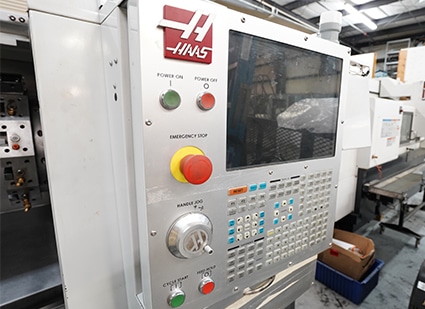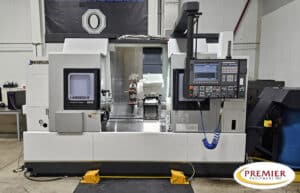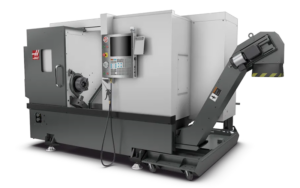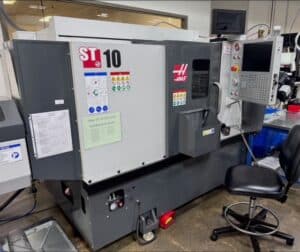You will come across two distinct control systems when looking for a used Haas CNC machine: the more recent NGC (Next Generation Control) and the more antiquated Legacy controls. When choosing which of these systems to buy, it’s important to know how they differ from one another. What you need to know is broken down in this guide.
What Are Haas Control Systems?
The computers that power Haas CNC machines are known as Haas control systems. They serve as the interface between you and the machine, allowing you to monitor operations, set parameters, and enter programs. What features are available and how you interact with the machine are determined by the control system.
Haas has created various control generations over time. Legacy controls and NGC systems are the two primary varieties found in the used market. Each has unique qualities that influence the machine’s functionality and capabilities.
Understanding Haas Legacy Controls
From the 1990s until 2015, Haas’s standard system was legacy controls. Haas’s reputation for dependability and user-friendliness was established by these controls. Their unique look and interface design will help you identify them.
Key Features of Legacy Controls
Hard buttons and a screen display are both used in the Legacy interface. Multiple windows are displayed on the screen at once, allowing you to view your program, tool offsets, and position displays simultaneously. Over the years, thousands of machinists grew accustomed to this layout.
Legacy controls are programmed using the conventional G-code format. Standard canned cycles for pocketing, tapping, and drilling are included in the system. Although it varies by model year, memory capacity usually falls between 1MB and 16MB. Even though this seems insignificant now, it runs the majority of common programs without any problems.
The generation determines the processor speed on Legacy controls. Models from the 2010s outperform earlier models from the 1990s. However, with the right programming, even older Legacy controls can manage intricate 3D toolpaths.
Advantages of Legacy Controls
Decades of use have demonstrated the dependability of legacy controls. Machines from the 1990s with their original control systems are still in use in many shops. The majority of CNC technicians are familiar with these systems, and parts and service support are still widely accessible.
There is a manageable learning curve. You can operate a Legacy control Haas if you know G-code. Operators can effortlessly switch between lathes and mills thanks to the uniform interface across various machine models.
Another benefit is cost. Comparable NGC-equipped models are usually more expensive than used machines with Legacy controls. Legacy controls offer great value for shops performing basic turning operations or 2.5D work.
Limitations of Legacy Controls
Legacy controls have limited graphics capabilities. Although the backplot displays tool paths, it is devoid of the intricate 3D simulation present in more recent systems. Verifying complex programs before running them becomes more difficult as a result.
There aren’t many options for network connectivity. RS-232 serial connections are used by older Legacy controls to transfer programs. Ethernet and USB were added in later iterations, but it can be difficult to integrate with contemporary shop networks.
Advanced features like advanced tool management and dynamic work offsets are either unavailable or require workarounds. Compared to modern technology, high-speed machining algorithms are less complex.
The Haas NGC Control System Explained
In 2016, Haas unveiled NGC, a radical overhaul of their control system. Next Generation Control, or NGC for short, is a significant change in Haas’s approach to machine control.
NGC Architecture and Interface
NGC has a 15.6″ LCD touchscreen and is based on a Windows architecture. It has a contemporary appearance and feel, much like a tablet or smartphone. You can alter layouts, pinch to zoom, and swipe between screens.
Compared to Legacy controls, the system’s dual-core processors have a lot more processing power. With options up to 8GB, standard memory starts at 1GB. Large programs and intricate 3D models are handled without lag by this.
Real-time graphics rendering takes place. Your part’s exact appearance is displayed in the 3D solid model simulation. Before cutting metal, you can check details by rotating, zooming, and sectioning the view.
NGC Capabilities and Features
Features that were not achievable with legacy hardware are included in NGC. Fixture variations are automatically compensated for by dynamic work offsets. When necessary, the Advanced Tool Management system automatically switches to backup tools based on tool life.
In addition to standard G-code, programming enhancements include conversational programming options. Depending on the material and tooling, the system recommends the best cutting parameters. Calculations for speeds, feeds, and thread milling are aided by built-in calculators.
Connectivity is designed for contemporary stores. NGC machines use Ethernet to connect directly to shop networks. You can check the status of your machine remotely from any location with HaasConnect. It’s easy to integrate with shop management software and CAM systems.
NGC Performance Benefits
Faster processors make motion control work better, especially on 3D surfaces that are hard to work with. Look-ahead algorithms handle more blocks of code, which speeds up complex tool paths. This means better surface finishes and shorter cycle times for the right jobs.
Setting up and using the touch interface is faster. Setting work offsets and checking tool lengths, for example, take fewer steps. Operators can get help videos and documents right from the control.
You can edit programs while the machine is running thanks to its ability to do more than one thing at once. You can get ready for the next job without stopping production. This cuts down on the time between parts.
Key Differences Between Legacy and NGC
User Interface and Experience
The most obvious difference is how you talk to the machine. Legacy controls have smaller screens with fixed layouts and physical buttons. NGC has a big touchscreen with displays that can be changed.
Some operators like physical buttons better because they can use them without looking. Some people like how flexible touchscreen interfaces are. Neither is better by nature; it depends on what you like and how you use it.
Processing Power and Memory
NGC systems can process data about ten times faster than Legacy controls from the last generation. Base NGC models have 100 times more memory space. This has an effect on the limits on program size and the speed of processing for complicated tool paths.
This extra power doesn’t matter much for simple 2D work. But NGC’s abilities really stand out when it comes to making complicated molds, aerospace parts, or medical parts that need to fit perfectly and have smooth surfaces.
Programming Options
The programs work with both systems because they both use standard G-code. But NGC also adds tools for visual programming and programming that lets you talk to the computer. These features make it easier for less experienced operators to write programs on the machine.
NGC also lets you use more advanced G-code features. NGC has better features for variable programming and macros.
Maintenance and Support
Legacy controls use technology that has been tested and repair methods that have been used before. Haas and other suppliers have a lot of replacement boards and parts on hand. These systems can be serviced by a lot of independent technicians.
Different skills are needed for NGC systems. Because the architecture is based on Windows, some problems require both IT and CNC experience. But Haas technicians can often fix problems without coming to your shop because they have remote diagnostic tools.
Choosing Between Legacy and NGC
There are a few things that will help you decide. Think about the type of work you do, how much money you are budgeting, how much experience the operator has, and what you want to do in the future.
When Legacy Controls Make Sense
Legacy controls are good for simple machining. You don’t need NGC’s advanced features if you’re just making simple parts with basic features. The lower price leaves money for tools or other gear.
Shops with operators who are already trained on Legacy controls can keep working without having to retrain. If your team has been using Haas machines for a long time, sticking with the same controls will make the changeover go faster.
Also, you need to think about maintenance. If you have technicians on staff who know how to work with Legacy systems, it’s easy to keep these machines running. Most Legacy models still have a lot of parts available.
When NGC is the Better Choice
NGC’s processing power helps with complicated parts. NGC’s advanced algorithms make it easier to machine medical implants, aerospace parts, and injection molds with fine details. These complex programs are easier to check with better graphics.
For flexibility, growing shops should think about NGC. The ability to connect to networks, keep an eye on things from afar, and add new features through software updates gives you room to grow. NGC machines are better at adjusting to new needs.
It’s often easier to train new operators on NGC. The easy-to-use interface and built-in help tools make learning faster. Conversational programming helps operators who aren’t very experienced get things done quickly.
Practical Considerations for Used Machine Buyers
When looking at used Haas machines, the type of control has a big impact on their value and capabilities. Here’s what to look at:
The version of the software is important on both systems. Legacy controls should be able to run the newest software for that generation. For the best performance and features, NGC systems need to be updated often. Find out what versions of software are already on the computer.
Be sure to check the condition of the control. Check that all the buttons work and the screen is clear on Legacy controls. For NGC, check the touchscreen’s responsiveness and look for dead pixels or other damage.
Think about the possibility of an upgrade. Some Legacy controls from later versions can add features or memory. You can add software options to NGC systems. You can’t change a Legacy control to NGC, though; you have to buy a new one, which costs a lot of money.
Inquire about the history of crashes. Control damage from crashes might not be obvious but can cause intermittent problems. Ask for service records that show repairs or replacements related to control.
Making Your Decision
Your shop can use either Legacy or NGC controls. Legacy systems are reliable and cost-effective for routine tasks. NGC gives complex parts and connected manufacturing modern connectivity and advanced features.
We have used Haas machines with both types of controls at Premier Equipment. Our technical team can help you figure out which system is best for you. We check the control systems of all the machines very carefully and give detailed reports on their condition.
You can keep your Haas machine running well with either Legacy or NGC by getting the right training and doing regular maintenance. When properly cared for, both control systems provide the reliability that Haas is known for. The best choice for you will depend on your needs, budget, and plans for the future.
Get in touch with our team to talk about the Haas machines we have in stock and find the control system that works best for you. We can help you learn what specific machines in our inventory can and can’t do.



